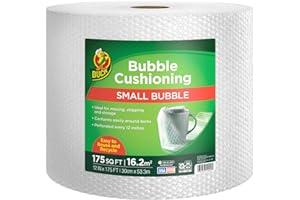Best Selling Bubble Wrap
Bubble wrap is a type of cushioning material made of a thin sheet of plastic film with small air bubbles trapped inside. It is used to protect fragile items during shipping and storage. Bubble wrap is available in a variety of sizes and thicknesses, and it can be made from a variety of materials, including polyethylene and polyvinyl chloride (PVC).
Bubble wrap was invented in 1957 by Alfred Fielding and Marc Chavannes, two engineers working for the Dow Chemical Company. The original purpose of bubble wrap was to be used as wallpaper, but it was not very successful in that role. However, Fielding and Chavannes soon realized that bubble wrap could be used to protect fragile items during shipping, and they began marketing it as a packaging material.
Bubble wrap is now one of the most popular packaging materials in the world. It is used to protect a wide variety of items, including electronics, glassware, and furniture. Bubble wrap is also used in a variety of other applications, such as insulation and soundproofing.
Links to Best Selling Bubble Wrap
Benefits of Bubble Wrap
Bubble wrap offers a number of benefits as a packaging material. These benefits include:
- Cushioning: Bubble wrap is a very effective cushioning material. The air bubbles inside bubble wrap provide a great deal of protection against shock and impact.
- Water resistance: Bubble wrap is water resistant, which makes it ideal for protecting items that are susceptible to moisture damage.
- Durability: Bubble wrap is durable and can withstand a lot of abuse. This makes it a good choice for protecting items that are likely to be handled roughly during shipping or storage.
- Reusability: Bubble wrap can be reused multiple times, which makes it a sustainable packaging material.
Drawbacks of Bubble Wrap
Bubble wrap does have a few drawbacks as a packaging material. These drawbacks include:
- Environmental impact: Bubble wrap is made from plastic, which is a non-renewable resource. The production of plastic also contributes to air pollution and climate change.
- Waste: Bubble wrap is often discarded after it is used. This can create a lot of waste, especially if bubble wrap is not reused.
- Pollution: Bubble wrap can be a source of pollution if it is not disposed of properly. Bubble wrap can be difficult to recycle, and it can also end up in landfills, where it can take hundreds of years to decompose.
Conclusion
Bubble wrap is a versatile and effective packaging material that has a number of benefits. However, it also has some drawbacks, such as its environmental impact and wastefulness. It is important to weigh the benefits and drawbacks of bubble wrap before using it as a packaging material.
